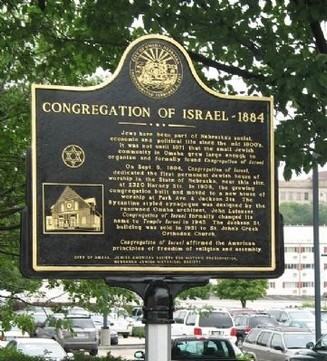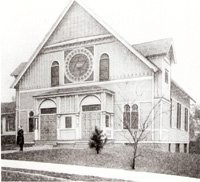Historical Marker: Congregation of Israel - 1884
Introduction
Text-to-speech Audio
Near the location of this historical marker was the first permanent Jewish synagogue in Nebraska. Built in 1884 and known as Temple Israel, this small synagogue served a growing Jewish community that started to form in the mid-19th century. In 1908, the congregation moved to a new location at Park Avenue and Jackson Street and built a new temple with large dome. The community worshiped at that location for several decades before selling their sanctuary to St. John's Greek Orthodox Church in 1951. Temple Israel is currently located at 7023 Cass Street.
Images
This historical marker was dedicated by the Jewish American Society for Historic Preservation and the Nebraska Jewish Historical Society with the support of the city of Omaha Photo by: Jerry Klinger

This temple at Park Avenue and Jackson Street was dedicated in 1908.

Backstory and Context
Text-to-speech Audio
The congregation was established in 1871 by eleven early Jewish settlers of Omaha. These founders first established a cemetery at 42nd and Redick as well as a burial society to observe Jewish customs and practices. The first congregants were led by their own members as they raised funds to construct a sanctuary and hire a rabbi. George Harfield was hired as rabbi in 1883 and the following year he dedicated the first synagogue in Nebraska at this location. N. I. Benson replaced Harfield and led the congregation from 1885 to 1889.
During the early years, tension between those who hoped to follow conservative Orthodox practices and those who supported the Reform view of Judaism that allows for individual interpretation of beliefs and practices threatened to divide the fledgling congregation. However, being the only members of the Jewish faith in an era of anti-Semitism united members who looked to find compromises on matters of ritual. One of the successes of this era was the establishment of a Sunday School that was free to all- including the children of many non-members.
During the early years, tension between those who hoped to follow conservative Orthodox practices and those who supported the Reform view of Judaism that allows for individual interpretation of beliefs and practices threatened to divide the fledgling congregation. However, being the only members of the Jewish faith in an era of anti-Semitism united members who looked to find compromises on matters of ritual. One of the successes of this era was the establishment of a Sunday School that was free to all- including the children of many non-members.
Sources
"Congregation of Israel - 1884." The Historical Marker Database. Accessed December 5, 2015. http://www.hmdb.org/marker.asp?marker=40743.
"Our History." Temple Israel. Accessed December 5, 2015. http://www.templeisraelomaha.com/about-us/our-history.
"Our History." Temple Israel. Accessed December 5, 2015. http://www.templeisraelomaha.com/about-us/our-history.
